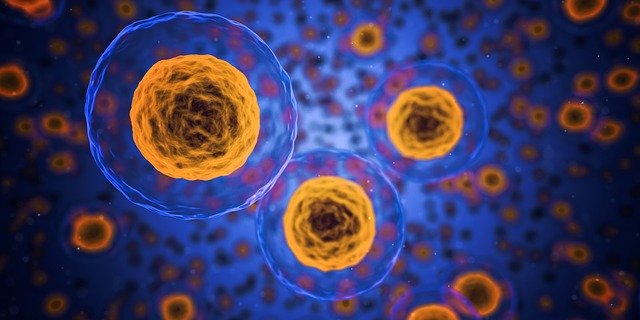Over a decade ago, stem cells were promised to repair virtually everything in our bodies, but over time researchers noticed that very few stem cells actually survive transplanting over the long term, and began looking at what stem cells (SCs) were doing to cause the resulting repairs being effected. The discovered that the usually injected SCs secrete tiny vesicles loaded with factors that promoted these repairs.
Stem Cells (SC) communicate with other cells by releasing tiny spheres, called extracellular vesicles, or exosomes, loaded with signalling factors; actually all cells communicate this way, but stem cells put out very regenerative factors. The promise now shifts to the use of vesicle-loaded medium harvested from SCs cultured in appropriate fluids, sometimes referred to as “Cultured Medium”. Recent studies have been tailoring the medium to optimize the vesicle production for specific purposes in therapeutics. The very cool thing about these vesicles is that they don’t retain the identifier of the owner of the SCs and thus cause no rejection issues like cell/tissue transplants.
The stew of signalling factors in vesicles is flavored by type and source of the cultured SCs, and so specific SC sources can be optimized to specific therapies. The study cited below is looking at the potential for certain SCs to induce senescent cells in our aging bodies to reverse age and start acting like younger cells capable of normal function and proliferation. The researchers are investigating the use of Mesenchymal Stem Cell vesicles for skin repair and rejuvenation. I personally would rather repair the missing cartilage in my left shoulder. Below are some readable excerpts from the study, and the title is a link to the published study
1. Introduction
The discovery of extracellular vesicles (EVs) or exosomes goes back to the 1940s, and these tiny vesicles were ignored as cellular garbage bins for a long time [
1,
2,
3]. They only began to draw significant attention around the mid-2000s after re-discovery of exosomes as messengers for cell-to-cell communications [
1,
4,
5,
6]. It is no exaggeration to say that we are at the dawn of the exosome era. There were more than three thousand publications on EVs or exosomes and related subjects in PubMed annually in 2018 and 2019 [
1]. The race toward commercialization of exosome-based therapeutics has already begun [
7,
8,
9,
10]. The top four exosome start-up companies, Codiak Biosciences, Exosome Diagnostics, Evox Therapeutics, and ExoCoBio have received approximately $386.2 million in investor funding [
8]. In addition, several big deals have been made between exosome start-ups and big pharma companies [
10].
Exosomes are nano-sized extracellular vesicles (EVs) released by almost all eukaryotic cells [
11]. In general, their size ranges from 30 nM to 200 nM. Two other subpopulations of EVs are microvesicles (100–1000 nM) and apoptotic bodies (500–2000 nM) [
12,
13,
14]. Exosomes derived from stem cells have attractive therapeutic potential in several aspects [
15]. It has been established that the mode of action (MoA) for therapeutic effects of stem cells is mainly paracrine effects mediated by secreted factors from stem cells [
6,
16]. Among parts of the secretome of stem cells, exosomes have been reported to play the major role in the paracrine effects [
16,
17,
18]. Mesenchymal stem/stromal cells (MSCs) are the most preferable source of therapeutic exosomes, since MSCs themselves appear to be safe based on huge amount of clinical data over the last decade [
15]. In addition, MSC-derived exosomes (MSC-exosomes) can be sterilized by filtration and produced as an off-the-shelf product, while MSCs themselves cannot. Moreover, MSC-exosomes are considered to be free from the safety issues in the context of cell-based therapy, such as tumorigenic potential by cell administration [
19,
20]. Indeed, MSC-exosomes have been applied as alternatives to MSCs for new cell-free therapeutic strategies in a variety of disease models including neurological, cardiovascular, immune, renal, musculoskeletal, liver, respiratory, eye, and skin diseases, as well as cancers [
15,
17,
19,
21,
22].
10. Conclusions
With the recent burst of research, MSC-exosomes are now widely accepted as next-generation cell-free therapeutics for intractable diseases. Many challenges in industrialization of exosomes are still out there such as large-scale culture of MSCs, continuous supply of MSCs with comparable therapeutic effects, and accurate determination of quantity and quality of exosomes. However, technical advances in the MSC cell therapy field, with the expected first marketing approval by the US FDA in the near future [
328], are also able to be integrated in the exosome industry soon. The use of immortalized MSCs, with similar functionalities and safety profile compared to naïve MSCs, might be also an alternative strategy for stable production of MSC-exosomes [
329,
330]. Successful commercialization of MSC-exosomes may provide a completely new therapeutic paradigm for human healthcare.
I believe that this strategy for tissue rejuvenation will develop rapidly into therapeutic products; my hope is that we get to commercial/supplement products that get around the drug industry monopoly so that reasonably priced supplements will arrive soon.
To your Greater health and fitness,
Frank
Frank Wilhelmi
Frank Wilhelmi - Retired/consultant electronic engineer researches and reports practical strategies for optimizing health and fitness into advanced age. “I have a passion for living life to the fullest, and helping others to do the same.” A rapidly growing body of knowledge now enables us to extend our health and fitness decades beyond popular expectations.

